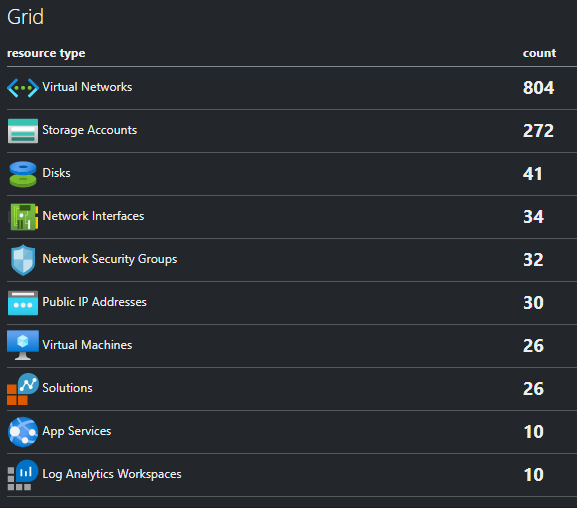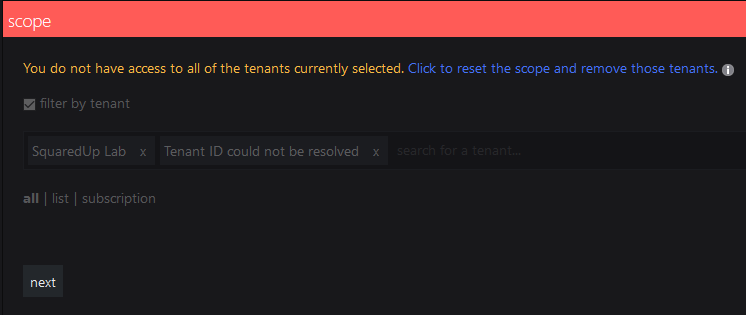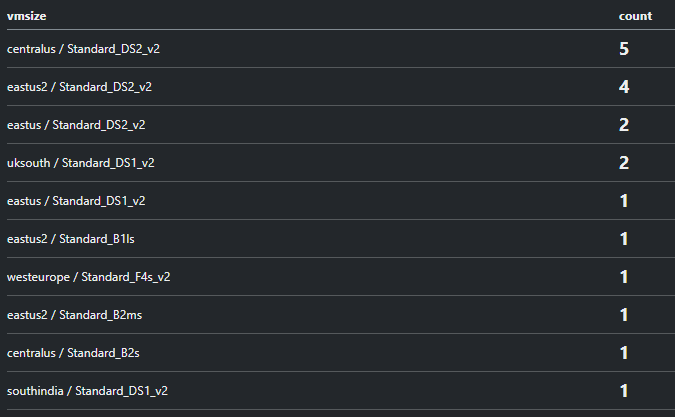Resources tile
The Resources tile contains two different kinds of tiles:
The Matrix tile shows health state, performance metrics and other information for a list of monitored resources.
The Resources Summary tile allows you to show a summary of resources, resource groups and subscriptions.
How to configure a Resource tile
- Create a new tile on a dashboard or perspective and select the Resource tile.

- Choose the type of Resource tile you want to configure:
Matrix
See How to use the Matrix tile
SummaryThe Summary Scalar visualization allows you to show the total number of all resources in a scope. For example you might set the scope to a particular subscription, then filter by type to show virtual machines and change the unit to 'VMs'.

The Summary Grid visualization allows you to show a table representation of the total number of resources for the scope and grouping you have specified. You can also group and sort the table.

The Summary Bar visualization shows you a graph representation of the total number of resources for the scope and grouping you specify.

- Scope:
Select the scope for your tile.Tip: If you experience any problems with scoping tiles, you'll find FAQs and help in the article How to scope tiles.
Note: By default, results are shown across all subscriptions (unless the subscription option is chosen to specify only one or more subscriptions).
Filter by tenantBy default results are shown across all tenants. In SquaredUp DS 4.7 and above a user who has access to multiple tenants will see a filter by tenant option.In a multi-tenant environment a user who does not have access to all tenants will see this message if they attempt to edit a scope containing tenants that they do not have access to. This may be because:
- One SquaredUp DS admin has added a tile scoped to tenants that other SquaredUp DS admins do not have permissions to.
- The customer/tenant is no longer serviced by this Customer Service Provider (CSP), so the tenant has been permanently removed for all SquaredUp DS admins.
Symptoms
A tile scope shows:
"You do not have access to all of the tenants currently selected. Click here to reset which will remove those tenants from the scope."
Tenants the user does not have access to show as:
"Tenant ID could not be resolved"

Procedure
The message warns users that they do not have permissions to all the tenants in the scope.
If the user chooses to reset and therefore edit the scope then the tenants that they do not have access to will be removed. If saved this scope will also have those tenants removed for users who do have access to them.
It is not possible for the user to edit the scope without those tenants being removed from the scope.
Where a tenant has been removed permanently you may wish to reset the scope to remove the unresolvable tenants.
ListList allows you to select several individual items to show.You can add multiple items. To remove an item click the x to the right of its name.Tip: Start typing and after two characters you'll see suggestions that match the name appear.Note: It depends on the tile what happens when you select more than one item. For example, when you select two virtual machines for a Status tile, you'll see the status of those VMs individually. When you select two virtual machines for a Cost Management tile, you'll see the cost for the two VMs added together.Resource groupSelect one or more resource groups.Filter by type:Tick filter by type to only show resources of a particular type within the chosen resource group.SubscriptionSelect one or more subscriptions from the dropdown box if you wish to restrict results to only one or more subscriptions. When this is not used results are shown across all subscriptions.Filter by type:Tick filter by type to only show resources of a particular type within the chosen subscription.TagsSelect items with a particular tag. Add the tag name and the tag value you want to use to search for. If you select multiple tags, the search automatically 'ANDs' the tags which means the scope only contains items which are tagged with all the tags listed.Filter by type:Tick filter by type to only show resources of a particular type within the chosen tag(s).TypeScope type can be used to show all resources of a particular type, for example all databases across all subscriptions, by typingdatabasesand selectingSQL databases.Show hidden typesThis works in the same way as the Show hidden types option in the Azure portal.Hidden types include some ancillary resources which are created/managed by Azure infrastructure. It might be useful to display these resources when cleaning up your resource groups or subscriptions.Note: If you never used a perspective, you should read Working with perspectives before scoping tiles on perspectives.
The power of perspectives is that tiles on a perspective can use a dynamic scope. A dynamic scope considers the currently viewed resource. A dynamic scope consists of two different states:
- the configuration of the scope in the tile (for example, "consider child objects of type logical disk for the currently viewed object")
- the actual resolved scope that depends on which resource you are currently viewing ("this object has 5 child objects of type logical disk")
After configuring the dynamic scope once in the tile, you'll get different results depending how the scope is resolved on the different resources you are viewing.
On perspectives, you can scope tiles to:
this resource
(only on perspectives for resources)The tile's scope will be the resolved to the resource that is currently viewed.child resources
(only on perspectives for resource groups and subscriptions)When you select this option, the scope of the tile will be resolved to all resources that are in the group or subscription that is currently viewed.If you want to narrow the scope down to a specific type of resource in the group or subscription, you can filter for one specific type of resource.other resourcesGives you the normal, non-dynamic scope options you are used to when scoping tiles on dashboards. This means the tile will not dynamically adapt it's content to the currently viewed resource, it will always show data for the static resource picked here.
Since the power of perspectives is that their tiles can show data for different resources depending on what resource is currently being viewed, you should only select this option when you are sure that there is no relationship between the desired scope and the currently viewed resource.
- Configure the settings for your visualization:
Scalar
Font sizeAllows you to set the font size of the value in the tile.
AlignmentSelect the scalar text alignment. Choose from left, center or right.UnitAllows you to add a unit to the value displayed in the Scalar tile. For example, if your value shows a time in milliseconds, you can enter "ms" or if your value shows pageviews, you can enter "pageviews".
Value formatterAllows you to format the value by using the mustache picker. For example, you can round the value up or down or convert it.
Color
Conditional formatting:
You can display the data in different colors based on values you define here. For example, you can display the data in green when the value is below 100 and in red when it is above 100.
- Click on add to configure a condition.
- Click on select color.... to open the color picker. Select the color for this condition.

- Enter your condition in the field next to the color. You can use the
valueproperty and manipulate it with JavaScript String and Regex APIs. When you click on the mustache picker, you'll get some examples:- Value is greater than something, less than something, etc.
For example:{{value < 10}}(The color you pick will be used if the value is less than 10) - Value is present in the result (scalar tiles only)
For example:value.IndexOf('error') != -1(The color you pick will be used if the string value "error" is present in the results) - Value matches one of the regular expressions you defined (scalar tiles only)
For example:value.match(/healthy|good|up/)(The color you picked will be used if the string values arehealthy,good, orup)
- Value is greater than something, less than something, etc.
Display:
Here you decide how the color is used:
Tile backgroundHighlight the tile in the color you defined.Text foregroundDisplay the text in the color you defined.Link options
Allows you to turn the graph item(s) into links. You can either enter plain text to create a fixed link (URL always stays the same) or use dynamic properties to create a dynamic link.
Dynamic links make use of dynamic properties which are inserted as part of the URL. This creates a template URL that will be resolved to an actual URL based on the items properties.
For example, if you want to link to tickets in your ticket system and the format of the URL for tickets in your system is
https://www.my-system/ticket-123, where123is the ticket ID, you can use the dynamic property that contains the ticket ID and enter the dynamic URLhttps://www.my-system/ticket-{{ticketID}}.- For scalars, you can only use the dynamic property
valuein dynamic links, which means the link changes when the value of the scalar changes. Since a scalar is just one item, it would also make sense to use a fixed link, for example the link to the website of which you are displaying the response time. - For status icon or bars and the rows of a grid, you usually want to use a dynamic link since you get multiple items or rows that represent different things. You can use any of the dynamic properties the mustache picker offers you.
Dynamic mustache properties and values you need to change according to your instance are highlighted in bold.
ServiceNow incidents:
https://<your-instance>.service-now.com/nav_to.do?uri=%2Fincident.do%3Fsys_id%3D{{sys_id}}PagerDuty incidents:
{{incident.html_url}}Azure DevOps projects:
https://dev.azure.com/<your-instance>/{{name}}Azure DevOps builds:
https://dev.azure.com/<your-instance>/_build/results?buildId={{id}}Zendesk tickets:
https://<your-instance>.zendesk.com/agent/tickets/{{id}}Azure Application Insights
https://portal.azure.com/#@squaredup.net/resource/{{ResourceId}}Grouping
Grouping
Allows you to control how the information is counted and displayed.
Note: If you've scoped to a resource type, such as Virtual Machines, then you should use another grouping method, such as resource group, tag, or custom.
Custom grouping:
Custom grouping allows you to group the resources being shown by any property or combination of properties, for example
{{location}}. You need to specify the properties just like you would do when you're creating a custom label, see How to use Custom Labels.Note: When the tile is scoped to a resource type or the resource type filter is set, additional properties become available for custom grouping. For example, you can define a label that includes the location property (always available) and the VM size property (only available when the scope is filtered to Virtual Machines) to group VMs by their location and size.
The Summary Grid below is grouped by type:

Sort
Sort allows you to change the order of the results displayed. You can sort by value (ascending or descending) or label (alphabetically ascending or descending).
If you activate the checkbox limit number of results displayed you can limit the results to a number of results (from the top).
Grouping
Allows you to control how the information is counted and displayed.
Note: If you've scoped to a resource type, such as Virtual Machines, then you should use another grouping method, such as resource group, tag, or custom.
Custom grouping:
Custom grouping allows you to group the resources being shown by any property or combination of properties, for example
{{location}}. You need to specify the properties just like you would do when you're creating a custom label, see How to use Custom Labels.Note: When the tile is scoped to a resource type or the resource type filter is set, additional properties become available for custom grouping. For example, you can define a label that includes the location property (always available) and the VM size property (only available when the scope is filtered to Virtual Machines) to group VMs by their location and size.
The Summary Bar visualization below is scoped to a subscription which is filtered by type to virtual machines. It is then grouped by custom > {{location}}:

Sort
Sort allows you to change the order of the results displayed. You can sort by value (ascending or descending) or label (alphabetically ascending or descending).
If you activate the checkbox limit number of results displayed you can limit the results to a number of results (from the top).
Data Range
The Data Range option allows you to choose the range of data the graph will display. For line graphs, this means the data on the y-axis.
percentageShows 0 to 100fit to dataShows the data minimum to data maximumfit to data (from zero)Shows from 0 to the data maximumcustomAllows you to specify the min and maxcustom fitAllows you to specify the min and max limits, so that data outside your settings will not be shown. If all the data falls within your specified ranges then the y-axis range will fit to the data rather than your caps. Click done to save the tile.
The tile now shows data according to your settings.
Walkthrough: Using the Summary Grid tile to show a count of all virtual machines by VM size
This walkthrough shows you how to add a Summary Grid visualization to a dashboard.
- Create a new tile and click Resources.
- Click on the Summary Grid button.
- In the scope panel add a resource group or subscription. Tick filter by type and in the box type
Virtual machines. - In the grouping section click custom. In the label box type
location / VM size. We're going to create a custom label. - In the value box copy and paste the following:
{{location}} / {{properties.hardwareProfile.vmSize}}
The mustache helper button to the right of the value box shows all the options available along with an example value. Instead of coping the mustache syntax above, you could select{{location}}from the dropdown list. Then type/and then click the mustache button again and select from the dropdown:{{properties.hardwareProfile.vmSize}}
For more information see How to use Custom Labels - In sort check that value and descending are selected.
- Click done.
